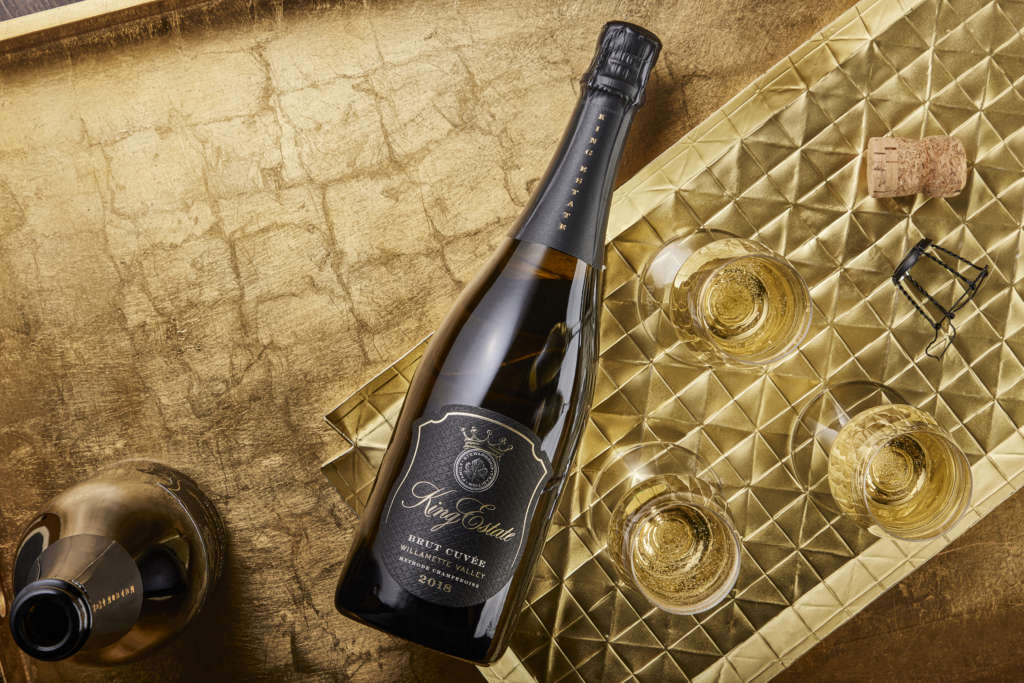Our new sparkling wine is here! The 2018 King Estate Brut Cuvée has arrived in time for upcoming festive celebrations with friends and family – and let’s face it, uncorking a bottle of bubbly makes any occasion festive. The journey from field to table is a long one for fine sparkling wine, beginning years before the first grape is ever plucked from the vine. It starts with finding the right site.
As it happens, Oregon is a great place to grow grapes for sparkling wine. Our cool climate conditions are similar to those of the Champagne region in France. King Estate predesignates the fruit that will be used for the sparkling program, planting it in blocks where the grapes will ripen the way we want them to. The vines are allowed to set a higher load, producing a denser crop. Fruit for our sparkling wine is always the first picked, when the brix, or sugar content, is low and acidity is high.
Sparkling vs. Champagne
Our Brut Cuvée is made according to the strict French standards known as the méthode champenoise, or the traditional method from the Champagne region. Grapes used in true Champagne are almost exclusively Pinot Noir, Chardonnay and, to a lesser extent, Pinot Meunier. Our 2018 Brut Cuvée is from 100% Biodynamic® estate-grown grapes, 60% Pinot Noir and 40% Chardonnay, both premium varietals grown in the Willamette Valley. Only Champagne originating in the French Champagne region can bear the Champagne name.
What is Brut Cuvée?
Brut means dry, and Cuvée can mean both a blend and the first pressed and most desirable grape juice. In this case it’s both: a dry blend of the first pressed grapes and most desirable juice.

Making Sparkling Wine, King Estate Style
Back in 2018, when the fruit was harvested, it was chilled overnight before pressing. Lightly pressing cold fruit releases fewer chemical compounds called phenolics that can cause bitterness. It takes more fruit to make the same amount of juice this way but it’s also what gives sparkling wine its softness and drinkability. After pressing, the base wines of Pinot Noir and Chardonnay are fermented separately in stainless steel until dryness before undergoing a second fermentation in bottle. The wine is then aged on the lees in bottle for three years where it develops rich, complex flavors.
When the wine was put down for aging, it was enclosed with a crown cap much like the cap on a bottle of soda. In the final stage in the process, the wine undergoes riddling and disgorgement to remove sediment resulting from aging. During riddling, the bottle is inverted so the sediment falls to the neck of the bottle and is captured in the crown cap. The neck is then dipped into dry ice, causing it to freeze and the cap to pop off, disgorging the sediment. (It’s like what happens when you put a bottled beverage in the freezer and forget to take it out, only more controlled.) Next the wine is finished with a liqueur d’expedition, a dosage of the blended wine that, while sweeter than the bottled wine, is still quite dry. Corking is the final step before the wine is ready for market.

Cheers to You!
When you pop the cork on the 2018 Brut Cuvée and pour yourself a flute, you will detect notes of pear, baked apple, white peach, brioche, floral blossom, damp slate and Meyer lemon. Fine and persistent bubbles offer a pleasant, delicate mousse with bright acidity lifting the fruit on the palate. This full-bodied wine features an elegant structure, with lingering acidity for a complex finish. Four years from start to finish, this Brut Cuvée is well worth the wait.
